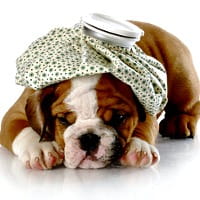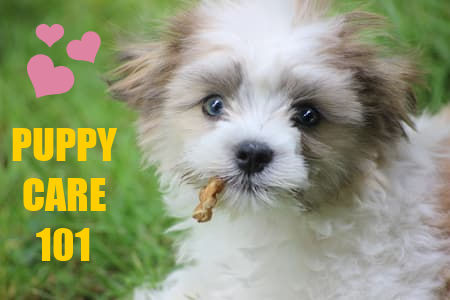FYI: If you buy something through a link on this site I may earn a commission - at NO extra cost to you.
How To Bottle Feed Puppies
This step by step guide shows you how to bottle feed puppies properly
Orphaned, abandoned or rejected puppies (or a small/weak puppy who can't nurse) need you to give them the nutrition that will keep them alive. Bottle feeding is usually the answer.
If you're faced with a tiny puppy (or a whole litter of them) who aren't able to nurse from their momma, it can be a very scary situation.
You might be wondering how on earth you're going to keep them alive let alone thriving!
But don't panic, many (MANY) other dog owners just like you have learned to bottle feed puppies and hand-raise them successfully.
You can too, the advice and information on this page will help you get together everything you need, and show you how to make sure the pup/s get the nutrition they need.
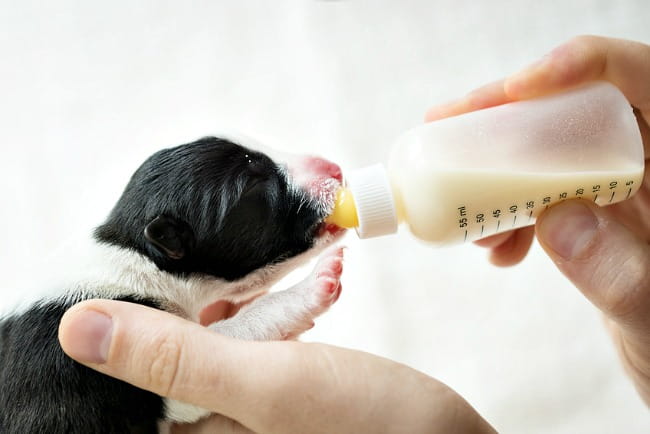
I'd also strongly recommend that you get your own veterinarian involved too. He/she will be able to give you the benefit of their advice and professional experience which is priceless.
Bottle Feeding Puppies 101
When you're bottle feeding puppies, it's important to use a puppy milk substitute that meets their special dietary needs.
Commercial puppy formulas that are carefully prepared to do just that can usually be bought at your veterinarians office or from large pet stores.
If your dog is pregnant, I would recommend getting some puppy milk in advance, so it's handy if you should need it. Feeding new born puppies is very similar to feeding new born human babies in that they need to nurse frequently! Every two hours during the day and probably once or twice during the night in the very beginning.
This adorable video shows a tiny French Bulldog being bottle fed...
If you're trying to feed a tiny, toy or miniature breed pup, they MAY be too small to feed well from a bottle, in that case there are other options including using a dropper, a sponge or the Miracle Nipple (best option). Scroll down to learn more about these!
Okay, so let's take a look at how to bottle feed puppies yourself, and the equipment that you need:
Momma's milk is the best food for a new born puppy. Try to encourage the mom to allow the pups to nurse for at least the first 24 hours if possible, as this is when they can receive the benefits of the colostrum (powerful anti-bodies and infection fighting pre-milk). Obviously this isn't always possible, but makes a big difference to the puppies.
Depending on the size of the breed your pups belong to, you can feed newborn puppies using:
- A small syringe (3ml) (check out the Miracle Nipple syringe)
- Special bottles designed for puppies or kittens
- Baby bottles (nipples that are specially designed for premature babies often work well)
- A sponge
- A tube
If there are no holes in the nipple, use a needle (held over a flame to heat and sterilize) to pierce two holes. Milk should drip out SLOWLY when the bottle is held upside down. If it runs out the pup could choke or aspirate (breath in) the milk.
Puppy milk replacement formula comes in powder form, or ready-made in cartons. The ready-made is easier to use, but quite a bit more expensive. If you're using the powdered version, be sure to mix it well as you don't want any lumps in it.
Cool formula to room temperature before feeding it to a puppy. You can test it on the inside of your wrist to make sure it's not too hot or too cold, it should feel barely warm.
Always feed a puppy face down on your lap or a table top, never hold it on it's back or upright, as this could cause it to choke or breath in the milk. This can lead to pneumonia and possible death.
Newborn puppies who are being bottle fed usually do well on 6 feedings per day. They should be able to go from 11pm until 6am as long as they are receiving 6 feeds in 24 hours. Smaller puppies may still need to be fed in the night for the first few weeks.
By three weeks old, 4 feeds a day is enough, and weaning can begin at around 4 weeks of age.
Puppies who are under a month old need approx. 3.5 - 3.75 calories per ounce of body weight, every 24 hours.
Example:
A 6 oz puppy would need approx 22.5 calories per day.
Most puppy milk replacers have about 1 calorie per ml, so that 22.5ml of formula can be divided between the 6 feeds.
This means a 6 oz pup needs approx. 3.75ml of milk per feed.
Of course, this is a rough estimate, some puppies need more, some less.
As a general 'rule of thumb', it's better to feed smaller feeds more often, than larger amounts less frequently.
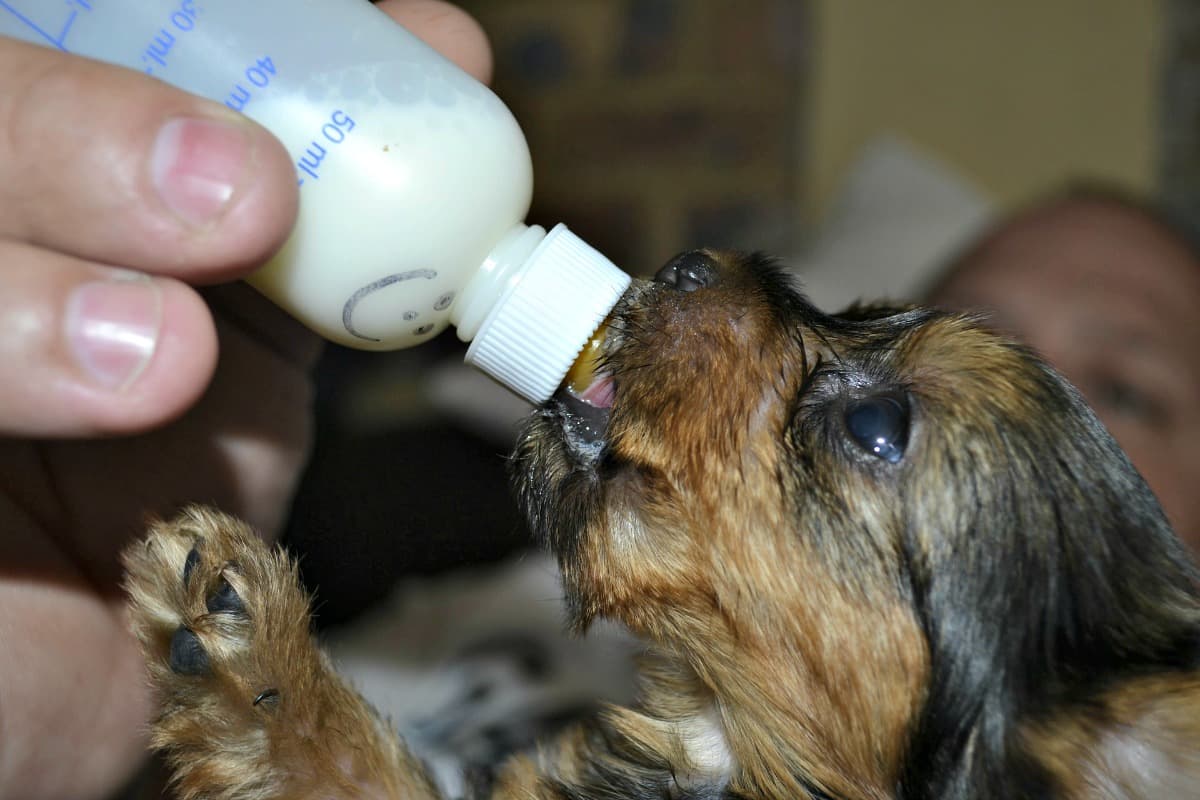
It's recommended that you 'burp' new born puppies half-way through each feeding. Do this the way you would with a human baby, by holding the pup up against your shoulder and gently rubbing or patting its' back.
If a puppy is getting enough to eat and is warm and comfortable, he will look plump, feel warm and sleep most of the time between feeds.
If a puppy is crying a lot, is always wriggling and squirming, or feels cool/cold and seems lethargic, you have a problem. In these instances, you should consult your veterinarian right away.
To help puppies who are having difficulty feeding, or aren't getting enough nutrition, you can use a vitamin and nutrient-rich paste called Nutrical.
I've used it myself for puppies who aren't thriving the way they should, and it is definitely something to keep on hand when you are hand-raising new born puppies.
Don't try to feed a puppy who feels chilled or cold, or seems to be sick.
If a new born pup gets too cold, his organs start to close down and feeding him will only make things worse. A cold puppy who isn't eating will get dehydrated quickly which is very serious.
If you can't get the pup warmed up enough to suckle fairly quickly, get him to your vet as he may need IV fluids and extra help.
After every feeding you'll need to help the puppies eliminate by gently rubbing their lower belly/genital area.
CLICK HERE to read more about all the other things you need to do in order to take care of new born puppies properly (including temperature control, tube feeding, weight gain monitoring and more).
Hand Feeding A Tiny/Toy Breed Puppy
Bottle feeding can be difficult for small breed puppies, especially the weaker ones or the 'runts' can be extremely tiny and weak.
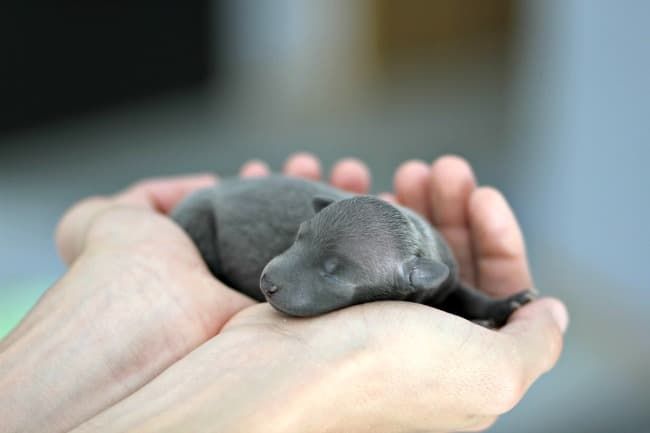
If you have teeny tiny puppies they might struggle with a bottle, and this is one of the situations where the Miracle Nipple Syringe can literally be a lifesaver.
The syringe kit comes with two flexible rubber nipples (can order small or large) which have a unique design that reduces the chances of a puppy aspirating the milk, and also provides a surface for the natural 'kneading' action that happens during nursing.
The Miracle Nipple also works great for kittens, rabbits and wildlife such as squirrels.
If your newborn puppy won't/can't suck from a bottle and you don't have the Miracle Nipple (yet!) you can try using an eye-dropper instead. Even the teeniest puppies are usually able to suck from these.
If they're too weak to suckle to begin with you can gently squeeze the milk into the side of their mouths at first (into the 'pocket' of the cheek, this helps to prevent the pup from choking, gagging or inhaling the milk).
Check out this great video which shows a very small Dachshund puppy ('Baby Girl') being dropper-fed
You could also use a syringe to gently 'inject' milk into the side of a tiny puppy's mouth in the same way, but once the pup is strong enough to suckle change over to an eye-dropper as that works better in the long run. There's also the option of sponge feeding.
But in my experience, the Miracle Nipple outperforms any of these and would be my #1 suggestion.
As your pup grows and puts on weight you should be able to 'graduate' to a bottle of some type, even if it's one designed for wild animals, or other pets such as baby rabbits and so on.
Tube Feeding a puppy
Sometimes a puppy is too small or weak to suckle, or simply refuses to try.
In this situation you need to find another way to get the milk into him. Tube feeding is usually recommended for puppies who can't/won't nurse.
There are risks involved because an incorrectly placed tube could flood the puppy's lungs.
It's important, and very helpful, to be shown how to tube feed your puppy by an expert, usually an established breeder or your veterinarian is the best person to help you with this.
Watching an experienced person tube feed a puppy and then practicing doing it yourself under supervision is the best way to learn.
I definitely DON'T recommend even attempting tube feeding without proper instruction and practice. It's quite possible that things will go wrong.
You will also need to get the right equipment. This puppy tube feeding kit has what you'll need to get started. Choose the 3.5 size for small breed puppies, either 5 .0 or 8.0 for mid-sized puppies and either 8.0 or 10.0 for large or giant breed puppies.
SPONGE FEEDING A puppy
Sponge feeding is a safer, gentler option to tube feeding IF your pup is strong enough to suck.
For this method you use can a small cosmetic sponge cut to approximate the size of the momma dog's teat, and also cut a small hole in the opposite end of the sponge.
It's a good idea to have several sponges ready cut for use so that you can wash and dry them in between feedings.
Fill a small syringe with the right amount of milk for the feeding and insert it into the hole you cut in the sponge.
Dip the other end (teat shaped) of the sponge in the milk and encourage your pup to suck on it. You may need to gently insert the sponge into his mouth and squeeze a few drops of milk out to encourage him.
Once he's sucking, slowly press the plunger on the syringe to pour milk into the sponge and keep it flowing slowly so the pup doesn't swallow air.. but slowly enough that he won't be flooded with it either.
This video shows you how to sponge feed a puppy:
Bottle fed puppies are at risk of Fading Puppy Syndrome, which can be fatal. It's important to know how to recognize this and what to do about it. Check out my page on taking care of newborn puppies to learn more about this (link will open in new window so you don't lose your place here).
Newborn Puppy Supplies
Now you know HOW to bottle feed those puppies, you need the right supplies to do it with!
Some you may be able to find at your local pet store, others you will probably need to order online.
If your dog is expecting a litter of puppies it's a good idea to make sure you have some of these handy ahead of time....
Reference books that can help.....
you might also like...
- Home
- Puppy Care
- New Born Puppies
- How Top Bottle Feed Puppies
FTC Disclosure: Some pages on this site contain affiliate links. I may earn on qualified purchases.




